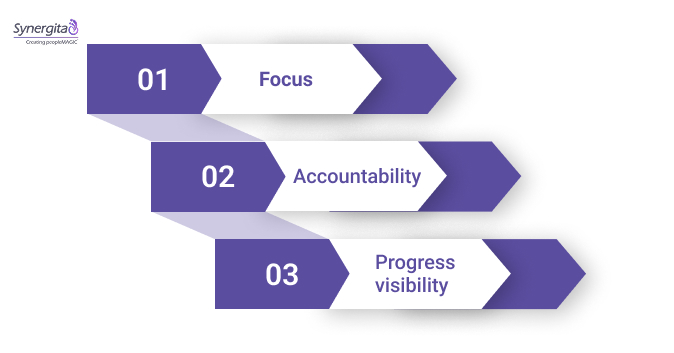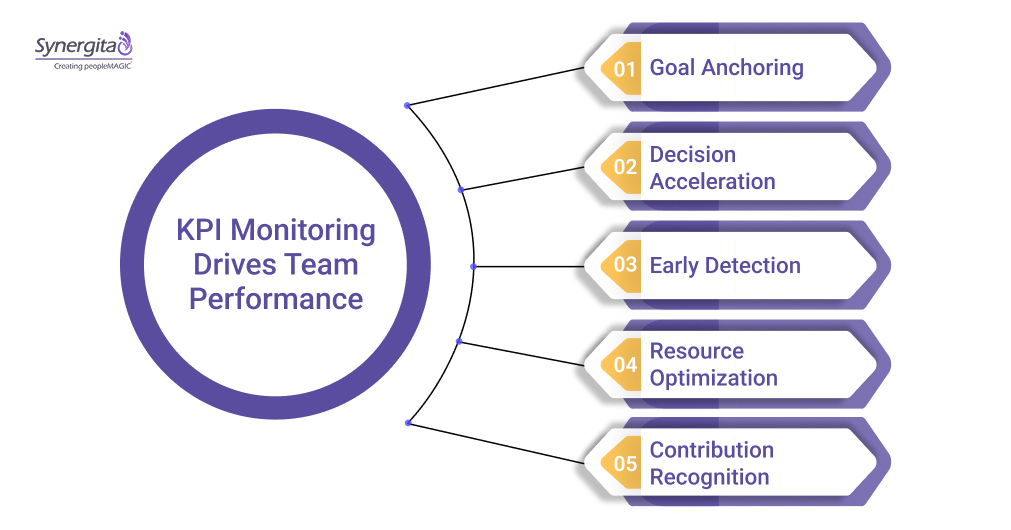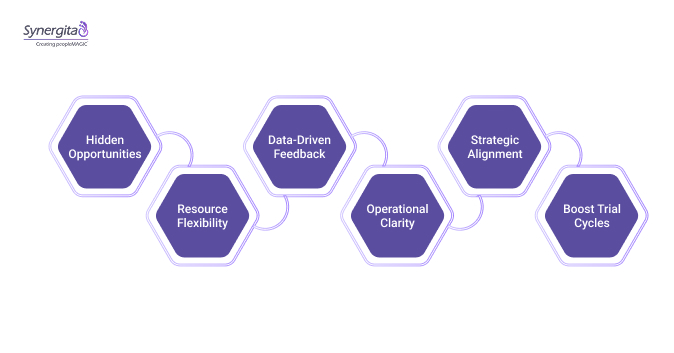Great teams don’t just work hard. They track what matters. Without real-time visibility into what’s working and what’s not, even the most ambitious goals can slip through the cracks. That’s where KPI monitoring steps in. It turns vague performance conversations into clear, data-backed actions.
And the pressure to get this right is growing fast. According to Forrester, “91 percentof finance leaders say they are planning to increase investments in performance management and reporting technologies in 2024.”
Whether you’re trying to align departments or spot red flags early, KPIs bring focus to the chaos. In this blog, we’ll unpack what KPI monitoring really means, why it matters more than ever, and how to make it work across your organization.
Key Takeaways
- KPIs are not just metrics; they are decision-making tools tied to specific business goals
- A strong KPI mix includes strategic, operational, functional, leading, and lagging indicators
- KPI monitoring improves focus, accountability, and early problem detection across teams
- Clear ownership, consistent review, and actionable dashboards drive performance alignment
- The most effective KPI systems don’t just measure performance; they shape better decisions
What Are KPIs and Why Should You Monitor Them?
KPIs (Key Performance Indicators) are measurable values that show how effectively a team, department, or business is progressing toward specific goals. Unlike general metrics like page views or hours worked, KPIs focus on outcomes that directly impact business success, such as churn rate, revenue per employee, or lead conversion rate.
Good KPIs are always tied to strategic objectives:
- “Monthly recurring revenue” supports revenue growth
- “Feature adoption rate” reflects product-market fit
- “Employee retention rate” signals team satisfaction and stability

Purpose of KPI Monitoring

KPI monitoring isn’t just about data collection. It serves three essential purposes:
- Focus: Teams understand what to prioritize and why it matters
- Accountability: Individuals and departments know what they’re responsible for
- Progress visibility: Leaders can see what’s working and where interventions are needed
When these three are in place, teams move faster with less friction.
Must read: OKR vs KPI: Know the difference they can make to your business
Types of KPIs to Monitor for Different Needs
KPIs are not one-size-fits-all. Different roles and business layers need different kinds of KPIs. Here’s how they break down, and how combining them can give you a 360-degree view of performance.
| KPI Type | Purpose and Use Cases |
| Strategic KPIs | Used by senior leadership to track company-wide goals. These include customer lifetime value, profit margin, and market share. Helps with long-term planning and investor reporting. |
| Operational KPIs | Tracked by middle management or agile teams to measure short-term execution. Metrics like turnaround time, order fulfillment rate, or bug resolution cycle fall here. These are reviewed weekly or monthly. |
| Functional KPIs | Tied to department-specific objectives. For example, sales teams monitor conversion rates, support teams track ticket resolution time, and HR watches employee retention. |
| Leading Indicators | Predictive in nature. These include pipeline volume, training completion rates, or site engagement. Used to forecast future performance. |
| Lagging Indicators | Reflect on past outcomes. Revenue growth, churn rate, and NPS fall in this category. These are important for evaluating overall success or failure. |
Blending KPIs for a Balanced Scorecard
To avoid blind spots, most high-functioning teams blend all five types. A balanced KPI dashboard may look like this:
- Strategic KPIs for quarterly board reviews
- Operational KPIs reviewed in sprint retrospectives
- Functional KPIs shared in team-level reports
- Leading indicators to shape next steps
- Lagging indicators to validate what worked
The mix ensures you are not just reacting to the past but actively shaping the future with real-time insight.
Also read: 13 Components for Successful Performance Measurement
Why KPI Monitoring Matters for Performance-Driven Teams

When growth slows or projects stall, the problem is rarely a lack of effort. It’s often a lack of clarity. KPI monitoring closes that gap. It sharpens the view on what truly drives outcomes, making it easier for teams to move from guesswork to grounded execution.
Here’s why it makes a difference:
- It anchors day-to-day work in long-term goals: KPIs ensure that even routine tasks connect to broader objectives. This keeps employees engaged with purpose and reduces wasted effort on low-impact work.
- It speeds up informed decisions: With up-to-date KPI data, managers don’t have to wait for quarterly reviews to course-correct. They can act on trends early and stay agile when conditions change.
- It surfaces problems before they grow: Missed deadlines or flatlining metrics can feel like symptoms with no clear root cause. KPI dashboards make it easier to isolate patterns and fix issues before they become systemic.
- It helps redistribute resources wisely: Not all underperformance stems from poor execution. Sometimes it’s a matter of misallocated bandwidth. KPI monitoring helps identify where teams are stretched thin and where there’s untapped capacity.
- It reinforces individual contribution: When employees see how their work affects shared outcomes, they’re more likely to stay engaged and accountable. KPIs connect the dots between effort and impact.
In performance-driven cultures, KPIs are not a reporting tool. They are a daily feedback loop that keeps teams aligned, informed, and ready to adapt.
Key Elements of a Strong KPI Monitoring System
A high-functioning KPI monitoring system is not just a set of spreadsheets and dashboards. It is a well-structured process that ensures the right data reaches the right people at the right time. Each element should serve the goal of making performance measurable, actionable, and consistently aligned with business priorities.
Here is what to focus on:
- Goal alignment should precede KPI selection: Before building a KPI system, ensure that organizational goals have been translated into department-level and individual objectives. Without this groundwork, even well-defined KPIs risk measuring noise instead of progress.
- Choose KPIs that are actionable, not just trackable: A KPI like “page views” is easy to track but not always meaningful. A better alternative would be “conversion rate from landing page to sign-up,” which ties directly to business goals and informs specific actions.
- Establish ownership with role-level clarity: Assign each KPI to an individual or a specific role, not a team. This avoids diffusion of responsibility and ensures that updates and interventions are not left hanging. Ownership also encourages proactive reporting and accountability.
- Automate where possible, but validate regularly: Pull KPI data from integrated systems like CRMs, HR tools, or analytics platforms to reduce manual error. However, automated data should be reviewed for context and relevance during each reporting cycle. Blind reliance on automation can lead to poor decision-making.
- Design dashboards for usability, not just visibility: A cluttered dashboard does more harm than good. Group KPIs by business function or user role. For example, executives should see strategic KPIs across departments, while product managers only need feature adoption, release velocity, and defect rates.
- Control for cognitive overload: Limit each stakeholder’s view to a curated set of KPIs that are relevant to their responsibilities. When everything is visible, nothing stands out. Prioritize clarity over quantity so teams can focus on metrics that move the needle.
- Ensure a built-in review rhythm: Whether weekly standups or monthly retrospectives, KPI reviews should not be ad hoc. A consistent cadence reinforces habits and makes performance tracking part of the team culture.
A strong KPI system is built for action, not observation. Every metric, every chart, and every owner should contribute to smarter, faster, and more aligned decisions.
Benefits of KPI Monitoring That Go Beyond Numbers

KPI monitoring is not just about checking boxes on a dashboard. When done right, it quietly transforms how teams think, plan, and grow. It helps shift organizations from reactive problem solving to proactive improvement.
Here are some of the lesser discussed but high impact benefits:
- Spot opportunities that aren’t obvious: Flat numbers don’t always mean failure. Sometimes they reveal potential. For instance, a plateau in customer churn paired with rising engagement metrics could signal the right time to launch a referral program. KPI monitoring allows you to connect the dots that siloed metrics cannot.
- Enable dynamic resource allocation: If a campaign is outperforming expectations mid-way, real time KPI monitoring lets teams shift budgets or manpower without waiting for a postmortem. The ability to pivot with data allows faster capital deployment where it counts most.
- Reframe performance conversations with data context: Instead of vague feedback like “You need to improve,” performance discussions can reference trends in owned KPIs. For example, a marketer might see that while leads are down, conversion rates have improved, changing the coaching approach from criticism to strategic problem-solving.
- Reduce operational guesswork at all levels: KPI dashboards don’t just inform leadership. When frontline employees have access to relevant metrics, like daily ticket resolution or feature usage, they make better micro decisions. Over time, these decisions compound into significant performance gains.
- Reinforce strategic focus across layers: Teams often juggle multiple tasks, but not all of them contribute equally to success. By anchoring work to visible KPIs, teams are nudged to deprioritize low-impact efforts and double down on what moves the needle. This focus scales across departments and functions.
- Accelerate experimentation cycles: When new initiatives are paired with early KPIs, such as engagement within 48 hours of a feature launch, feedback loops shorten. This means teams can iterate, test, and course correct faster, making innovation safer and more consistent.
The most effective KPI systems are not just reflective but transformative. They don’t just tell you what happened; they shape what happens next.
Challenges and How to Overcome Them in KPI Monitoring
Even with the best intentions, KPI monitoring can backfire if not thoughtfully implemented. To make KPI tracking a strategic advantage rather than a reporting ritual, embed it into your team’s operating rhythm with the following approaches:
1. Information overload blurs priorities
When teams track dozens of KPIs without prioritizing, high-impact insights get buried in noise.
Solution: Create a KPI hierarchy based on business strategy. Focus on a small set of critical metrics, with secondary KPIs supporting them. Let strategy, not data availability, dictate what you track.
2. Static KPIs lose relevance over time
A KPI useful during a launch may not matter during a retention phase, yet many teams keep tracking it.
Solution: Conduct monthly or quarterly KPI audits. Remove metrics that no longer provide fresh insights, and replace them with ones that match the current business stage.
3. Tracking fatigue and demotivation
Over-monitoring can make employees feel scrutinized, pushing them to chase vanity metrics instead of real outcomes.
Solution: Shift focus from raw numbers to meaningful outcomes. Tie KPIs to real business results and celebrate improvements, not just targets hit. Keep measurement balanced so it supports, not pressures, teams.
4. KPI ownership without clarity
When responsibilities are unclear, KPIs sit on dashboards without action.
Solution: Assign clear owners for each KPI. Define what actions they’re responsible for if targets are missed or trends change. Review progress in regular team check-ins to maintain accountability.
5. Dashboards that display data but don’t inspire action
Pretty charts alone won’t improve performance if they’re not discussed.
Solution: Design dashboards for collaboration. Highlight anomalies, trends, and conversation starters. Incorporate KPI reviews into daily standups or weekly meetings so data turns into decisions.
How Synergita Makes KPI Monitoring Work for Growing Teams
Scaling organizations often struggle with connecting big-picture goals to everyday execution. Synergita bridges that gap with tools purpose-built for alignment, visibility, and continuous performance improvement. Here’s how it supports effective KPI tracking at every level:
- OKRs that cascade from strategy to execution: Synergita’s platform helps you break down company-wide objectives into departmental and individual goals. This cascading structure ensures every KPI has context, accountability, and a direct line to the larger mission.
- Performance management that connects KPIs with growth: Appraisals and feedback are no longer isolated events. With Synergita, KPI data feeds into performance reviews in real time; ensuring evaluations reflect actual outcomes, not just subjective opinions.
- Real-time dashboards with AI-powered insights: Synergita’s intuitive dashboards bring KPIs to life. Whether you’re tracking customer retention or project velocity, AI recommendations guide your next steps; be it coaching, reallocating resources, or adjusting timelines.
- Recognition and development tied to impact: Instead of generic praise or training, employees receive recognition and learning opportunities based on actual performance metrics. This turns KPIs into tools for motivation and professional growth.
- Seamless integrations with everyday work tools: Synergita connects with platforms like Jira, Slack, and Microsoft Teams so KPI updates flow naturally into your team’s daily workflow. No more context switching or duplicate data entry.
Ready to turn your performance data into actionable growth?
Book a Demo and see how Synergita makes KPI monitoring scalable, smart, and simple.
Conclusion
KPIs are not just a management tool. They are a mirror for your team’s focus, a guide for your next move, and a signal when change is needed. When monitored with intention, KPIs can unlock clarity, improve alignment, and help teams perform with purpose.
But tracking the right numbers is only half the battle. Making them visible, actionable, and tied to daily work is where true transformation happens.
Want to see how that looks in action? Start your free trial and explore how Synergita helps teams track what matters, improve faster, and grow together.

FAQs
Q: How do KPIs differ from regular metrics?
A: While all KPIs are metrics, not all metrics are KPIs. KPIs are specifically chosen because they reflect progress toward strategic goals, whereas regular metrics may simply track activity or operational data without indicating success or failure.
Q: How often should KPIs be reviewed?
A: It depends on the nature of the KPI. Strategic KPIs may be reviewed quarterly, operational KPIs monthly, and team-level or functional KPIs weekly. Consistent review ensures they stay aligned with business priorities.
Q: What makes a KPI effective?
A: An effective KPI is specific, measurable, and directly tied to a business goal. It should prompt action, be owned by someone accountable, and offer insights that help guide decisions and improvements.
Q: Can KPIs change over time?
A: Yes. As business goals evolve, KPIs should be revisited and refined. What mattered during a product launch may no longer be relevant post-scale. Regular evaluation ensures continued relevance and impact.
Q: Should every employee have their own KPIs?
A: Ideally, yes. Individual KPIs aligned with team and company goals help employees understand their contribution, stay focused, and take ownership of outcomes.
Q: What tools are helpful for KPI monitoring?
A: Dashboards, performance management platforms, analytics integrations, and goal-tracking tools are essential. They ensure real-time visibility, automate reporting, and make KPIs part of daily workflows.

